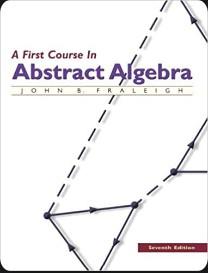Let R be an ordered ring with set P of positive elements, and let < be the
Question:
Let R be an ordered ring with set P of positive elements, and let < be the relation on R defined in Theorem 25.5. Prove the given statement. (All the proofs have to be in terms of Definition 25.1 and Theorem 25.5. For example, you must not say, "We know that negative times positive is negative, so if a < 0 and 0 < b then ab < 0.")
If R is a field and a and bare positive, then a/b is positive.
Data from 25.5 Theorem
Let R be an ordered ring with set P of positive elements. Let <, read "is less than," be the relation on R defined by a < b if and only if (b - a) ∈ P for a, b ∈ R. The relation < has these properties for all a, b, c ∈ R. Trichotomy One and only one of the following holds: a < b, a = b, b < a.
Transitivity: If a < band b < c, then a < c.
Isotonicity: If b < c, then a+ b a + c. If b < c, and 0 < a then ab < ac and ba < ca.
Conversely, given a relation < on a nonzero ring R satisfying these three conditions, the set P = {x ∈ R |0 < x} satisfies the two criteria for a set of positive elements in Definition 25 .1, and the relation <p defined as in Condition ( 1) with this P is the given relation <.
Proof Let R be an ordered ring with set P of positive elements, and let a < b mean (b - a) ∈ P. We prove the three properties for <.
Trichotomy: Let a, b ∈ R. By the trichotomy property of Pin Definition 25.1 applied to b - a, exactly one of (b - a) ∈ P, b - a = 0, (a - b) ∈ P holds. These translate in terms of < to a < b, a = b, b < a respectively.
Transitivity: Let a < band b < c. Then (b - a) ∈ P and (c - b) ∈ P. By closure of P under addition, we have (b - a) + (c - b) = (c - a) ∈ P so a < C.
Isotonicity: Let b < c, so (c - b) ∈ P. Then (a + c) - (a+ b) = (c - b) ∈ P so a + b < a + c. Also if a > 0, then by closure of P both a(c - b) = ac - ab and (c - b)a = ca - ba are in P, so ab < ac and ba < ca.
Step by Step Answer:






